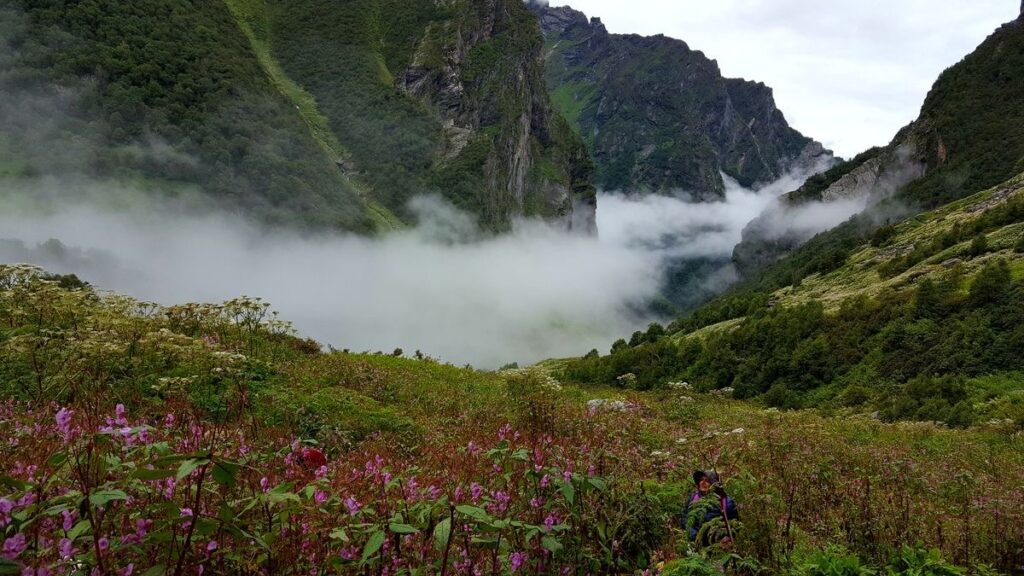Introduction

The Valley of Flowers in Uttarakhand is one of India’s most enchanting natural wonders, known for its breathtaking meadows of endemic alpine flowers and diverse flora. Declared a UNESCO World Heritage Site, this magical valley is part of the Nanda Devi Biosphere Reserve and is situated at an altitude of about 3,658 meters in the Chamoli district of Uttarakhand. The region transforms into a vibrant carpet of colors during the monsoon season, attracting trekkers, botanists, and nature lovers from across the globe.
If you are planning your trip in 2025, this guide will provide you with everything you need to know about the Valley of Flowers trek—including the best time to visit, trekking routes, permits, accommodation, and essential travel tips.
History and Significance of the Valley of Flowers
The Valley of Flowers National Park has a fascinating history. It was discovered in 1931 by a group of British mountaineers led by Frank Smythe, who was mesmerized by the sight of this blooming paradise. Over the years, it has become one of India’s most celebrated trekking destinations.
Apart from its visual beauty, the valley holds cultural and mythological significance. Local legends believe that this valley was once home to fairies and gods. Even today, it is considered a sacred site by the locals.
Location and Accessibility
The Valley of Flowers is located in the Chamoli district of Uttarakhand, near Joshimath and Govindghat. To reach this destination, travelers usually follow this route:
- Rishikesh/Haridwar to Joshimath (270 km) – Accessible by road.
- Joshimath to Govindghat (22 km) – The base point for the trek.
- Govindghat to Ghangaria (14 km trek) – The mid-point and base camp for both Valley of Flowers and Hemkund Sahib.
- Ghangaria to Valley of Flowers (4 km trek) – Final stretch leading to the stunning valley.
The trek is moderately difficult and is suitable for beginners with basic fitness levels.
Flora and Fauna in the Valley of Flowers
The valley is a paradise for botanists and wildlife enthusiasts. It is home to more than 600 species of alpine flowers, including Brahma Kamal, Blue Poppy, Cobra Lily, and Himalayan Bellflowers. Each species blooms at different times, ensuring that the valley always looks fresh and vibrant.
In addition to flowers, the valley is also home to rare wildlife species such as:
- Himalayan black bear
- Snow leopard (rare sighting)
- Musk deer
- Blue sheep
- Himalayan monal (state bird of Uttarakhand)
Best Time to Visit Valley of Flowers
The Valley of Flowers trek is open only from June to October, as the rest of the year it remains covered in snow.
- June – Early Bloom: The valley begins to open, and snow starts melting.
- July – August – Peak Bloom: The best time to visit when the valley is full of vibrant colors.
- September – Autumn Beauty: Fewer flowers but clear skies and pleasant weather.
👉 Best Time: Mid-July to August is considered the perfect time to witness the valley in full bloom.
Valley of Flowers Trek Itinerary
Here’s a 6-day itinerary for the Valley of Flowers trek:
Day 1: Rishikesh/Haridwar to Joshimath (drive, 8–9 hrs)
Day 2: Joshimath to Govindghat → Trek to Ghangaria (14 km)
Day 3: Trek from Ghangaria to Valley of Flowers (4 km) and return
Day 4: Trek to Hemkund Sahib (optional, 6 km steep trek)
Day 5: Return trek from Ghangaria to Govindghat → Joshimath
Day 6: Drive back to Rishikesh/Haridwar
Permits and Entry Fees
To enter the Valley of Flowers National Park, you need a permit:
- Entry Fee: ₹150 (Indians), ₹600 (Foreigners) – valid for 3 days
- Children below 12 years are free
- Extra charges for cameras
You can obtain permits at the entry gate in Ghangaria.
Accommodation Options
Since there are no hotels or camps allowed inside the valley, travelers stay at Ghangaria, which offers:
- Budget lodges and guesthouses
- GMVN guesthouse (Government-run)
- Camping options with tents
Tip: Book in advance during the peak season (July–August).
Travel Tips for Valley of Flowers
- Carry raincoats and waterproof gear, as monsoon showers are frequent.
- Wear sturdy trekking shoes with good grip.
- Avoid plucking flowers; the valley is ecologically protected.
- Carry first-aid and necessary medicines.
- Stay hydrated and keep energy snacks handy.
- Trek early in the morning to avoid afternoon rains.
Nearby Attractions
While visiting the Valley of Flowers, you can also explore:
- Hemkund Sahib (4,633 m) – A sacred Sikh pilgrimage site located close to the valley.
- Badrinath Temple – One of the Char Dham pilgrimage sites.
- Auli – A popular skiing destination.
- Mana Village – India’s last village before the Tibet border.
Why Visit Valley of Flowers in 2025?
With the increasing popularity of offbeat travel, the Valley of Flowers trek remains one of the best experiences for nature lovers. In 2025, improved infrastructure, eco-friendly tourism initiatives, and better connectivity make it even more convenient for travelers.
Whether you’re a seasoned trekker, a nature photographer, or someone looking for spiritual rejuvenation, the Valley of Flowers promises a once-in-a-lifetime experience.
Conclusion
The Valley of Flowers National Park in Uttarakhand is not just a trek; it’s an experience that takes you closer to nature’s untouched beauty. From vibrant blooms and rare wildlife to snow-capped peaks and cultural heritage, this valley is a traveler’s dream come true.
If you’re planning a Himalayan trip in 2025, don’t miss the chance to walk through this colorful paradise. The Valley of Flowers trek is the perfect blend of adventure, spirituality, and natural beauty..